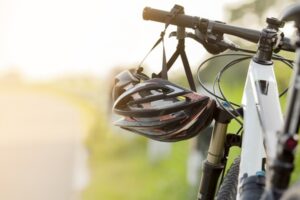To avoid the pain and ED visits for head injuries, a properly fitted bike helmet can help protect your child or teen from a serious brain or head injury. People ages 10-24 account for the highest rates of bicycle-related injuries treated in emergency departments (EDs). Yet, the CDC estimates that only 25% of children ages 4 to 15 wear helmets when riding their bikes, and the number for older teens is nearly zero. To increase helmet usage, parents are encouraged to educate their children about helmet safety and remind them to strap one on before leaving home.
 No Helmet = No Ride
No Helmet = No Ride
- Set a good example and enforce the No Helmet = No Ride policy in your home for both kids and adults. You may not look as cool, but remember that your children pay more attention to what you do than what you say.
- Ensure the helmet fits appropriately—level and flat, not tilted forward or backward. It should be low in the front, about two finger-widths above the eyebrows, and fitting snugly to keep it from moving around. Adjust the straps to form a “Y” around your child’s ears for the correct fit.
- Take care of the helmet, and don’t let your kids throw it around. If a child is involved in a crash, replace the old helmet with a new one. Once a helmet has been damaged, it won’t protect as well as it should, even if it looks okay.
- Store the helmet with the bike or even hang it on the handlebars. This will be a reminder to put it on before riding and keeps it from getting lost.
- Let the child know what could happen if they do not wear a helmet. Don’t make it a point to scare, but make the consequences known so he or she will think twice before leaving without it.
Bike Safety Rules
Although helmet safety is a big part of bicycle safety, it is also important for parents to teach their children about other safety rules:
- Teach them arm signals and how to signal when making a turn. Many accidents happen when cyclists turn because pedestrians and drivers don’t know where the cyclist is going.
- Obey traffic laws and signs. Cyclists should always travel in the same direction as general traffic and follow all signage, such as stop or yield signs.
- Stop and look twice before crossing a street, even though some areas seem to have less traffic. Most accidents happen close to home because the riders are so used to the area, they become careless.
- Wear bright or light-colored clothes, which help others see cyclists before it’s too late. Also, pairing such clothing with reflectors is a great way to be noticeable while on the road.
- Wear proper shoes—don’t go barefoot or wear open shoes, such as flip-flops or sandals.
Begin talking about these rules and enforcing them as soon as a child learns how to ride a bike. Even before that, if you give your child rides in a bike trailer, fit them for a helmet and wear one yourself, as well as demonstrate how to use arm signals.
By introducing bicycle safety rules and encouraging them from the beginning, children are more likely to understand their importance and remember them—even when they are old enough to ride without supervision.


